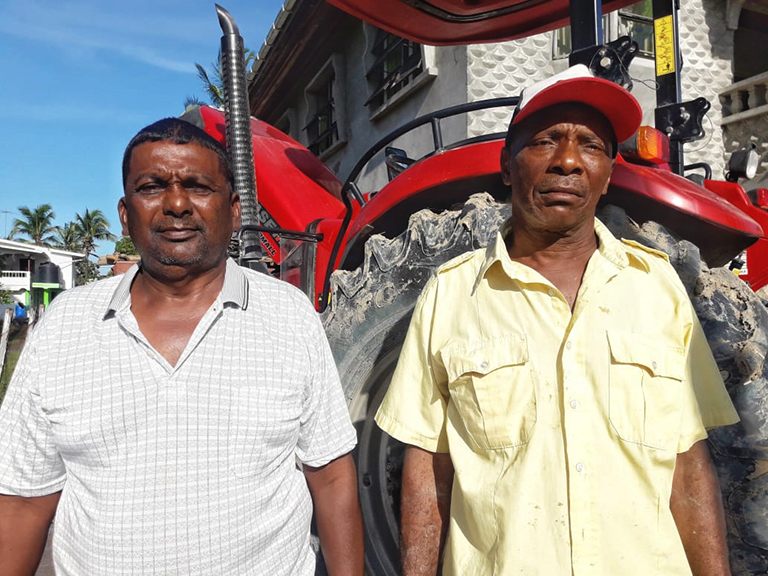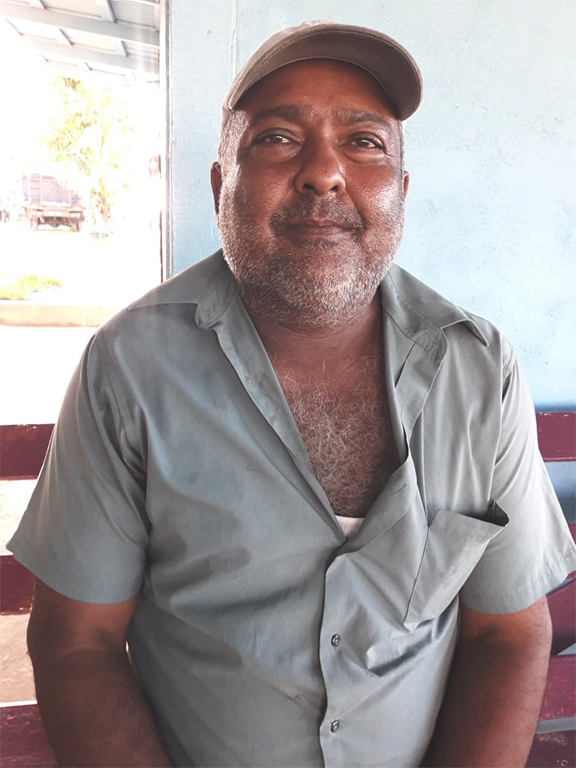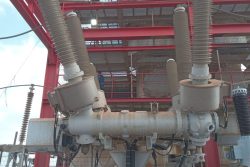The West Bank Demerara district once widely known for its sugar production owing to the now defunct Wales Sugar Estate, is now predominantly under rice cultivation as many of the cane farmers have made the switch following the closure of the estate.
Derrick Venture, a rice, sugarcane, and cash-crop farmer, resides in a community called La Retraite. Venture was in the process of washing his tractor with his pressure-washer. As fast as he cleaned the tractor of the mud covering it, a lot of it ended up on him.
He was all too happy to engage with this newspaper and even invited fellow rice farmer, Tuladat Lall of Canal Number One who had stopped at the tyre shop in the neighbourhood to join in the discourse.
“Up to this morning, I was spraying bugs on my farm,” Lall said, explaining that it is best to check for the pests in the early mornings or late afternoons as it is difficult to spot them during the day when the sun is at its peak.
Venture who only got into rice farming three years ago as a result of the closing of Wales Estate mentioned that he has observed a pattern with the bugs plaguing the farms and that rice farms usually see an abundance of them every other crop. A crop is considered every three months. The men explained that the bugs seems to survive well during the rainy season. Although they couldn’t say why this is so, they opined that was because the pesticides were being washed off during the wet season.
According to the men, the Ministry of Agriculture from the previous administration along with the Guyana Rice Development Board (GRDB) and an overseas-based specialist were earlier this year advising farmers on the preventative measures to control farm pests. Presently Venture said, the GRDB field staff is spraying pesticides on the dams around the farms. However, farmers are responsible for the spraying of their farms.
“These bugs would find safe haven along the dams until the paddy on the farms actually burst out. They [bugs] would feed on the pollen [which is said to be of a milky nature] before it turns into the paddy. If you leave it like that and you take it to the rice mill, it would be damaged grain. That would result in a different range of low prices for a bag. The grade [varies]. There is extra A, A, B, C, Sample 1 and Sample 2 to Sample 6”, Venture explained.
The more a rice farmer puts into producing his crop, the better the crop is, but of course, the costlier it’ll be. Venture disclosed that during this present crop, he has sprayed his rice with pesticide three times already. “As they say, ‘the eyes of the farmer fatten the calf’. If you know you invest in something, you try to go the extra mile to see everything is fine, to see that your water is not blowing away because you have eels that would bore the banks and the water would escape or whether you need to put more fertilizer here or see if pests [are] among the rice. So I’m in the farm every day, just to monitor it.”
Of the new government, Venture said, “We want them to play an integral role in the agricultural sector.”
“It’s a lot of cost in chemical, fertilizer, fuel cost, maintenance of farm machines to produce a bag of paddy. We pay VAT [value added tax] on almost everything in machinery. We want them to lessen the VAT. We can’t say no VAT, the country got to survive,” Lall said.
Lall plants rice in the nearby communities of La Retraite, Toevlugt, and Nismes. In fact no one resides in Toevlugt. The entire area is mainly rice fields. An old run-down rice mill that once operated for some thirty years is the sole building and landmark in Toevlugt. Often times when the paddy is harvested during the wet season, farmers could be seen spreading the paddy along the sides of the West Bank Demerara Public Road to dry.
Lall has been a rice farmer for more than forty years and currently plants about a hundred acres of rice.
“I was planting about forty acres of sugarcane before the estate closed but after the closing I had to divert to planting rice. Some of the land was rented. Currently I just have 5 ½ acres in rice. It was not economical to remain planting cane and having to take it all the way to Uitvlugt through the back dam. A ten-acre plot of cane will take you two weeks to harvest and take to the factory while rice is one-day operation because you would use a combine. With sugar you have to transport [it] through the back dam but with rice we can take it along the public road,” Venture said. He currently plants twenty-five acres of rice, all of which were sugarcane before. Both men take their bags of paddy to the Abdool Hakh and Sons Rice Milling Complex situated at Harlem, on the West Coast of Demerara. Venture is also the current secretary of the Stanleytown/La Retraite Cane Farming Society, one of the last of the cane farming societies still existing. The society has forty-five members from Stanleytown, La Retraite, and Canal Number One, who still plant sugarcane.
Combines
For farmers who are unable to purchase combines, which would be most of them, they would rent the machines instead. However, as shared by both farmers, one doesn’t pay rent for the combine or according to the amount of acres reaped. In fact, farmers pay per bags of paddy produced. Asked whether it won’t be cheaper if they paid for acres of farm instead, the men explained that an acre of rice could produce forty or twenty bags of paddy depending on the condition of the crop, whether good or bad.
According to Venture, because his profit margin isn’t substantial, he plants cash crops on the side to supplement his earnings.
Meanwhile, when asked whether they’d want more money for their rice, Lall responded that they would surely welcome it but he doesn’t see how it would be possible since countries in Asia are planting rice on a larger scale and that Guyana has to compete with the prices set by the international market and with countries producing far larger quantities of rice.
Roger Watson sat in his car on the public road outside of the defunct rice mill in Toevlugt. “I’m planting rice more than fifty years now. It started as a family business. The rice farming started with my grandfather so it’s more than a century since we planting rice,” Watson said.
The farmer noted that he has almost forty-five acres of rice, all grown in La Retraite. He spoke of observing the GRDB field staff spraying the dams around his farm whilst he was pumping water into his rice fields. The man added that sometimes he sprays his fields himself and at other times, he pays labourers to do so.
Also a cane farmer, Watson said that the amount of cane to be harvested is barely seventeen trailers. “Most of the cane land, I converted it to rice. My family started planting rice first, then cane and now we’re back to planting rice. Having to take the sugar to the estate is strenuous. For instance on the morning when is harvesting time, 4 o’clock in the morning I got to get up for cane cutters, take them in the back dam for five, then transport two loads of cane to Uitvlugt. I’m leaving like five in the morning to get there and I reach minutes to seven and sometimes midnight or one o’clock in the morning, I can’t reach home as yet, just for two trailers cane and look the distance. Sometimes when midnight reach, they tell you, they can’t [offload] and that the factory break down and I got to drive all the way back from Uitvlugt. It’s way more feasible to plant the rice,” said the farmer.
As a rice farmer, Watson said that he is set and hasn’t any sort of challenges. However, he admitted that he could do with better irrigation for his farm.
Omkar Das, is a rice farmer who lives in Eccles, both he and his father farm in Toevlugt and Nismes. Between the two, they have eighty acres of rice. Das shared that his family owns a stall in the Stabroek Market which between the seventies and eighties was suffering, not having commodities to sell. During that time, his father saw farm lands advertised for sale and jumped at the opportunity.
“We started planting rice and cane and after they closed the [Wales] estate, we converted the cane lands into rice lands and now we’re solely doing rice cultivation. Back in those days, it wasn’t that hard in producing cane but for rice it was difficult because we didn’t have the required machinery. We had to do majority of the work manually in terms of catching the paddy and bagging. Sugar was doing better economically than rice but then the industry (sugar industry) started making a plunge. This was like a little over a decade prior to the closing of the estate,” Das said.
Speaking about the bug infestation, Das said that the rice fields have been sprayed with pesticides three times already and still have to be sprayed again. For every thirty acres, Das noted they use approximately $5,000 worth of pesticides. In addition, he has to find the wages for his workers.
Explaining the prices paid for bags of paddy based on the grade, Das said, “When you have like D and under grade D, you’ll be getting like $1,500 to $1,800 per bag. For grade D and C, you’ll be getting like $2,000 to $2,200 a bag, for C and B you’ll get like $2,500 to $2,700 for a bag, and $3,000 for A, extra A is $3,100. The catch is they [the millers] will tell you the price that you want to hear but when you get there, they will find all kinds of excuses to tell you that you didn’t make the quality of grade for that price. You will see as you pick your paddy up, that there is no bug bite and that it is quality but when it gets to the mill, they will tell you that although you have purity of more than eighty-five percent in the sample, you’re still getting B and C grades. Back in the days GRDB used to control everything but they don’t now; this was way before 1992. The millers have the upper hand now. I want this administration put things back in place where GRDB can have the final say of our earnings.”
According to the rice farmer, it doesn’t pay to have just a rice farm. One needs to have some other means of income adding that while their rice production would have supplemented their grocery shop in the city, it is the shop that now steadies the family and not so much the farm.
Rice farmer, Ishmeel Khan also known as ‘Miley’ lives quite some distance along the Coghlan Dam at Pouderoyen. The producing of the rice by the family began with Khan’s grandfather. The family currently owns acres of rice fields in Nismes and way down in Coghlan Dam.
For Khan, he’s never known any other occupation than being a rice farmer except as a cash crop farmer adding that he cannot depend on rice alone to maintain his extended family inclusive of his parents. In fact, the man’s wife and children sat at a table of boulangers, celery and eschallots, among other vegetables tending to customers as they came. The family has never planted sugarcane.
Coghlan Dam, the man said, is one of the fortunate areas to have an all-weather road leading to the back dam unlike many of the other rice fields. This is one of the developments, he hopes is taken care of under the new administration. In addition to this, he would like to see better drainage and irrigation. Nismes area, he added, needs more irrigation as the land there is higher.
According to the man, during the Burnham administration, there was what was called the “Agri Bank” – the Guyana Cooperative Agricultural and Industrial Development Bank. The bank according to the man, provided loans for farmers. This system has long been done away it. Farmers wanting loans are now required to visit commercial banks. What they now receive is called a “working capital”. The millers would provide farmers with the necessary fertilizers, which the equivalent in Guyana dollars is discounted after the rice is harvested and taken to the mill.
With regard to GRDB overseeing the prices paid per bag of paddy decades ago, Khan agreed with Das that this served the farmers better. However, Khan does not believe that the private sector will ever again give the government the opportunity to have a say in the prices and while he can look forward to and make requests for various developments in the rice industry, subsidies from the government isn’t one he foresees happening in the near future.











